When autumn sweeps across the north, Alaska fall colors transform the tundra into a painter’s dream of red, gold, and orange. In this post, Tamron Ambassador Alyce Bender shares how to make the most of the fleeting season—from photographing Alaska landscapes and wildlife to chasing the aurora in Alaska—all with a lightweight, minimalist Tamron lens kit. Whether you’re planning your first trip or refining your Alaska photography tips, these insights will help you capture the wonder of the last frontier in fall.
By Guest Contributor and Tamron Ambassador Alyce Bender
What You’ll Learn in This Blog Post:
- Why photographing Alaska in autumn offers some of the most vivid fall foliage Alaska has to offer.
- What minimalist gear to pack for lightweight travel without compromising creative control.
- How to go beyond grand landscapes to discover intimate moments in nature.
- Pro advice on handling the unpredictable weather of landscape photography Alaska.
- How to photograph the aurora in Alaska and capture unforgettable wildlife encounters.
Why Alaska Fall Photography Is So Unique
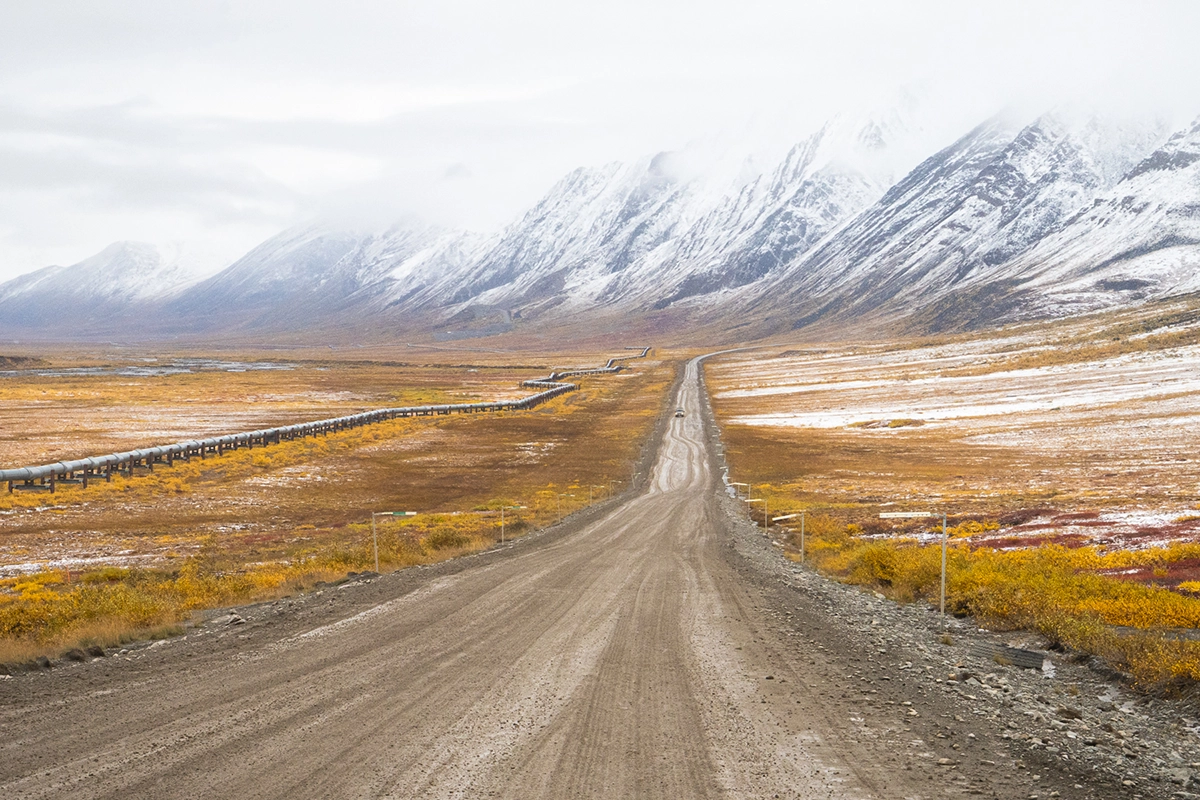
Each time I drive the Dalton Highway, I’m reminded how quickly Alaska transforms. This was my third trip north, but the first time I completed the full route—an achievement not guaranteed with the road’s unpredictable conditions. These drives have given me countless Alaska photography tips I now share through my work.
- From Forest to Tundra: The Dalton begins in boreal forest, winding past spruce and birch before climbing into the Brooks Range. Beyond those peaks, the land opens into Arctic tundra—vast, treeless, and painted with incredible fall color perfect for Alaska landscape photography enthusiasts.
- A Blaze of Early Color: By late August, the tundra ignites in crimson, gold, and orange, making Alaska fall colors one of the earliest in North America to showcase autumn’s brilliance. The short season feels both fleeting and endless under long northern light, perfect inspiration for anyone photographing Alaska in the fall.
- Two Seasons in One: During this trip, I witnessed the first major snow of the season in the Brooks Range. Fresh snow met the still-glowing tundra below, allowing me to capture the rare convergence of fall and winter in a single frame—color and contrast in perfect balance.
- Travel Prepared: Conditions on the Dalton can shift from sun to snow to slick mud within hours. This remote road rewards only the prepared. Always carry extra food, water, blankets, CB radio, and emergency flare.
Pro Tip: Start your fall color photography season here in Alaska’s Arctic. You’ll catch peak hues early, leaving time to chase autumn southward through September and October—a great start for Alaska photography tours or workshops.
Essential Lightweight Gear for Alaska Photography
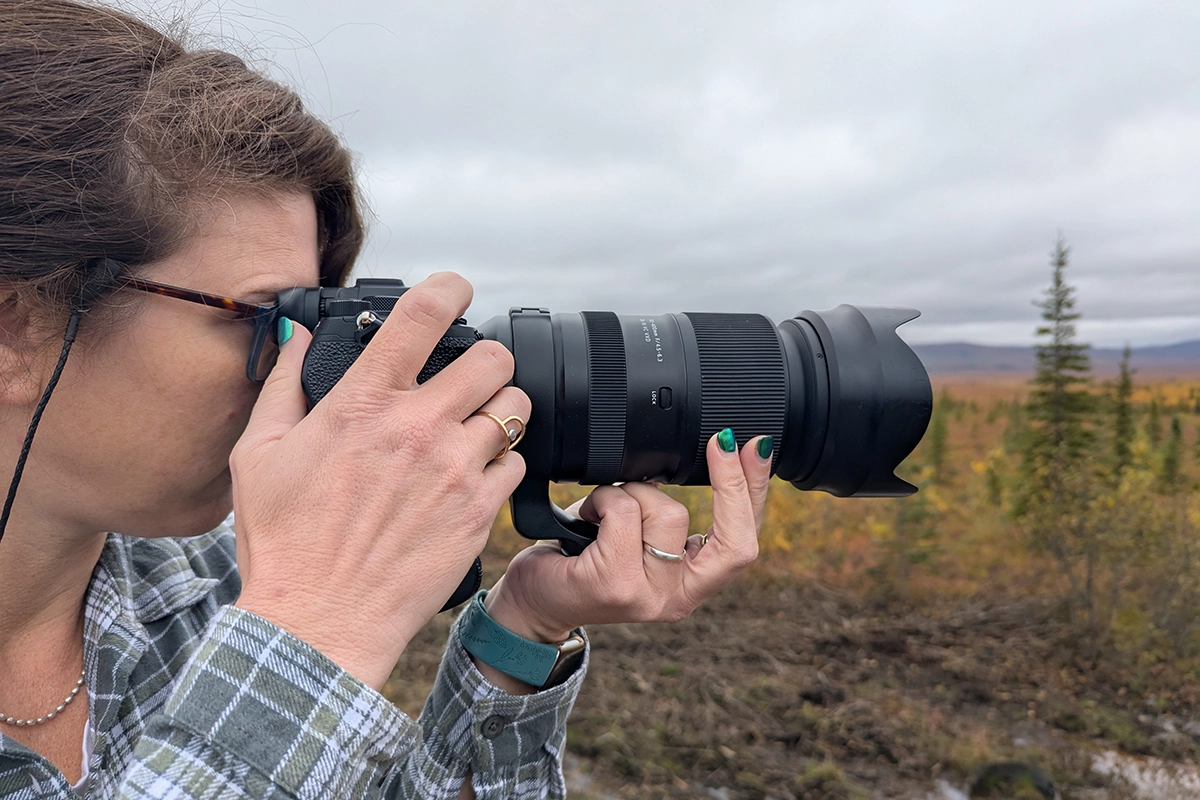
When venturing into Alaska’s wilderness, every ounce matters. On expeditions like this, space for camera gear competes with safety essentials—fuel, recovery tools, food, and first aid. Safety first, with photos a close second.
Pro Tip: Bring or rent a 4×4 vehicle approved for the Dalton Highway. Its gravel grades, steep passes, and unpredictable weather test both driver and machine—but the views are worth every mile for anyone planning an Alaska landscape photography road trip.
Balancing Practicality and Creativity
Flying into Fairbanks adds another layer of planning. All equipment must comply with airline restrictions and fit within what I can personally carry through the airport. Compact, durable gear is key to a minimalist travel photography gear strategy—especially when exploring Alaska landscapes.
Building a Minimalist Kit
The Ideal Lens Kit: For this expedition, I packed two Sony bodies—the A1 and A7RV—paired with what I call my Dynamic Duo of lenses: the Tamron 17–50mm and 50–400mm. Together, they covered everything I could ask for—from sweeping tundra views to intimate wildlife portraits ideal for Alaska wildlife photography projects.
- Tamron 50–400mm F/4.5–6.3 Di III VC VXD: My workhorse for wildlife photography in Alaska—grizzlies, caribou, and foxes. Compact for its class, fast to focus, and impressively sharp across the range.
- Tamron 17–50mm F/4 Di III VXD: My choice for broad landscapes, moody light, and colorful tundra scenes. Excellent contrast and color with just the right amount of reach.
Both lenses are weather-sealed, and I’ve tested that thoroughly—from Caddo’s humidity to Japan’s snow to Alaska’s shifting mix of dust, rain, and sleet. Their lightweight builds kept fatigue low and creativity high on long shooting days. They remain among the best lenses for both landscape photography in Alaska and wildlife photography in Alaska.
Ready for Any Light: Pairing the Sony A1’s speed with Tamron’s clarity gave me confidence from dawn to dusk. My minimalist photography kit didn’t limit me—it gave me freedom to respond quickly, stay safe, and stay present in the beauty of Alaska’s wilderness.
Pro Tip: When weight matters, versatile zoom lenses are worth their weight in gold. One lens that shifts effortlessly from grand landscape to wildlife close-up means more time focused on moments, not gear.
Capturing Alaska’s Fall Colors in Peak Season
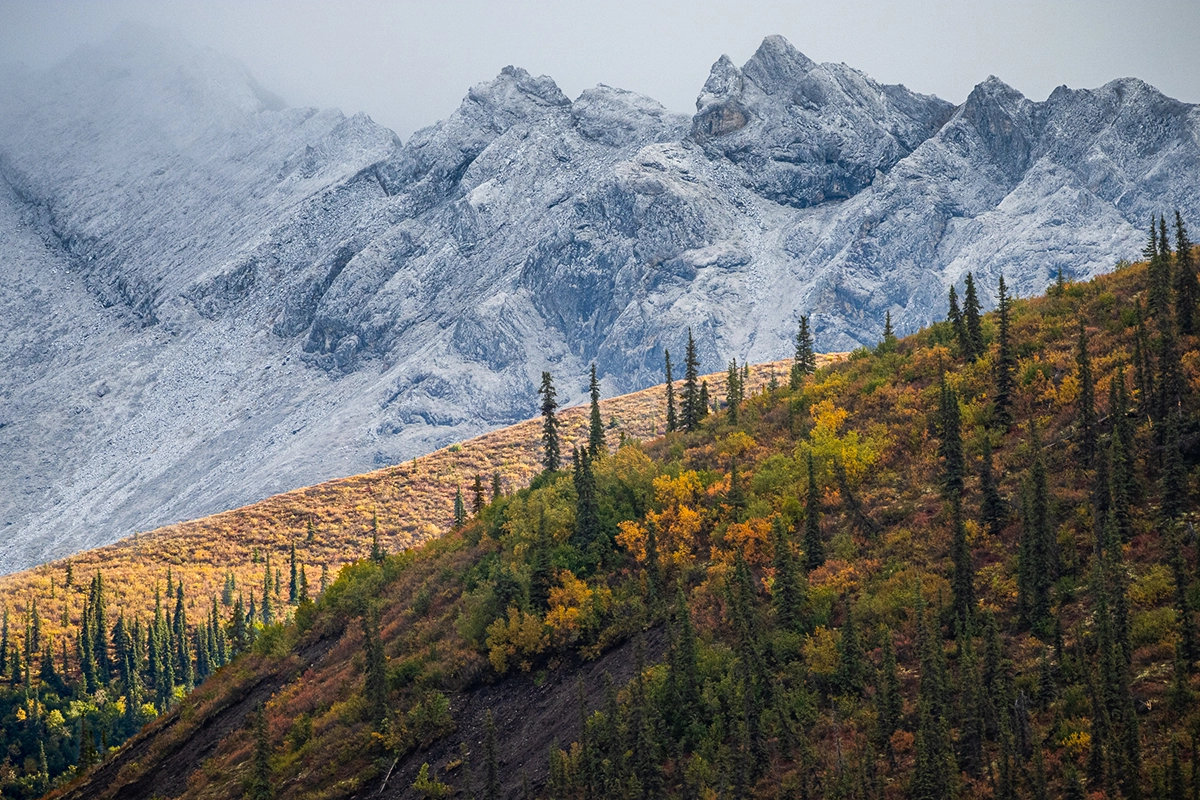
By late August, the Arctic tundra bursts into color. The hills blaze red and gold while the Brooks Range stands dusted in early snow. It’s fleeting beauty—one week of pure color before winter begins its slow takeover.
Light and Mood in the Far North
Moody weather shapes everything here. Overcast skies reveal texture, while sudden breaks of sun ignite the land in brilliance. These shifting skies often deliver rainbows arcing across the mountains, layering even more color into the scene—ideal for any autumn photography tips list or Alaska landscape photography experience.
Framing the Vastness
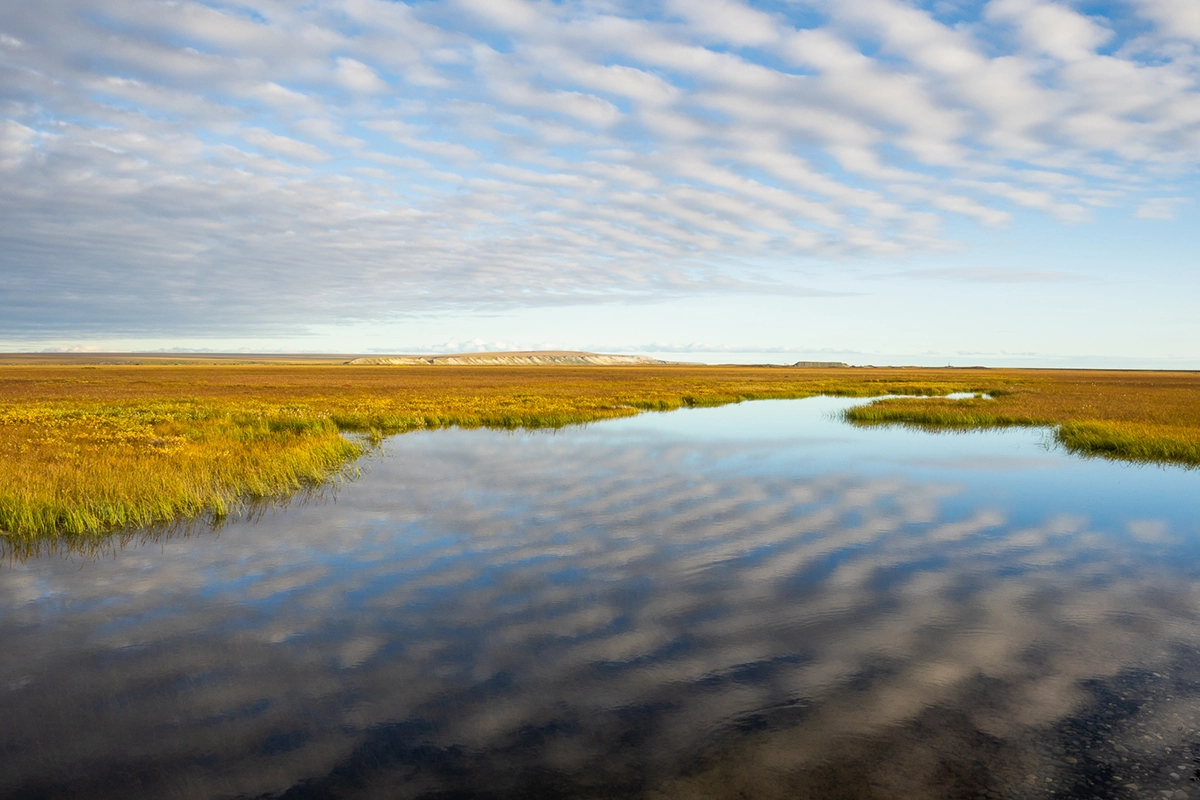
The Tamron 17–50mm became my choice for wide views—perfect for capturing reflections in tundra ponds and the soft symmetry of sky mirrored in still water. In contrast, the Tamron 50–400mm let me compress the layers of Alaska’s landscapes, revealing its grand scale in a way the eye alone can’t.
Together, they offered two perspectives on the same story—one expansive, one intimate—each helping viewers feel both the immensity and the quiet intricacy of the Alaskan fall landscape.
Small Wonders Among Giants
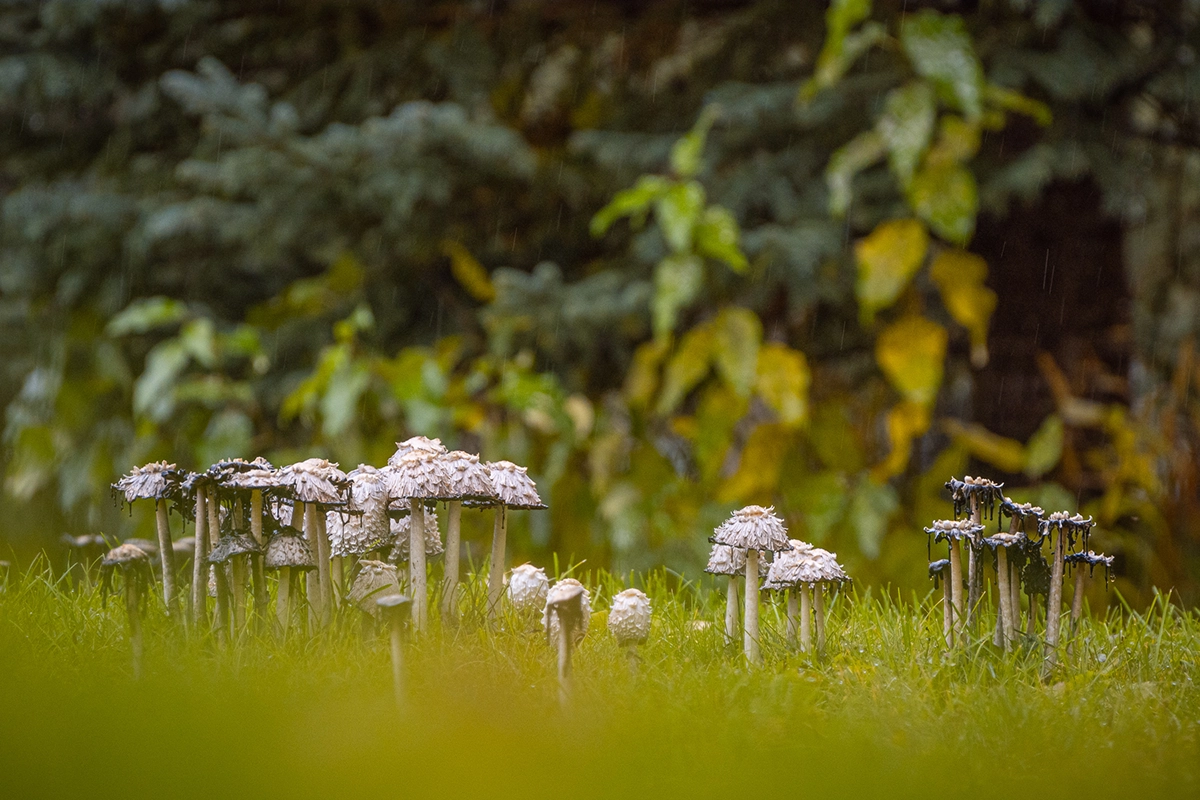
Not every shot was grand. I knelt often among moss and birch leaves, drawn to droplets clinging to leaves and tiny mushrooms pushing through velvet moss. These details create powerful Alaska fall colors images that celebrate the quieter side of the tundra—proof that Alaska landscape photography isn’t always about wide views but about paying attention to nature’s finer details.
Pro Tip: Alaska’s fall color peaks fast and weather moved quickly. Track forecasts with apps like Windy or Clear Outside. Shooting just after rain gives richer tones and perfect droplets for detail studies.
Wildlife Photography in Alaska’s Autumn Wilderness
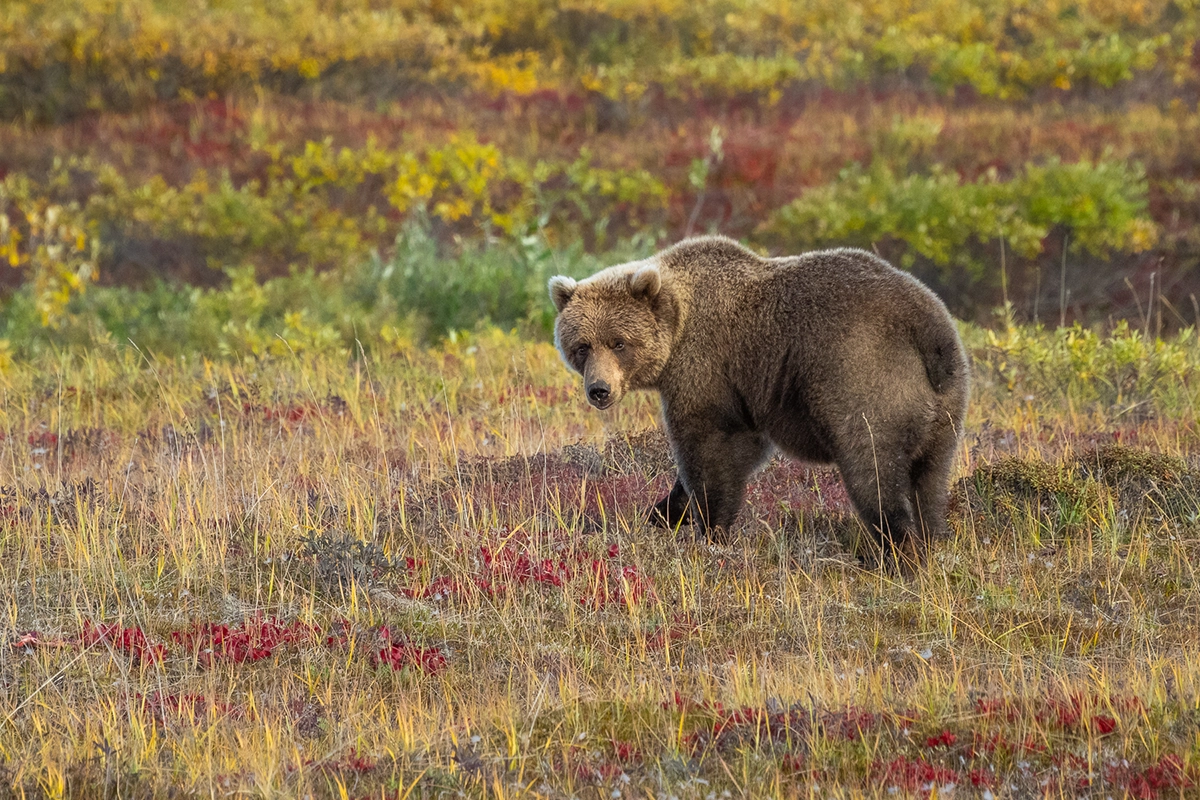
Alaska wildlife photography in autumn feels urgent. Bears feed heavily before hibernation, caribou drift across open valleys, and red foxes hunt in the soft gold of fading daylight. Every creature seems aware that winter waits just beyond the horizon.
Reading Behavior and Light
I often parked quietly, watching through the windshield before reaching for my camera. The Tamron 50–400mm gave me the reach to stay at a respectful distance while still capturing behavior and texture—fur catching light, breath visible in the chill.
Moments in Motion
For wildlife, I prefer shooting in Manual mode to maintain full control of shutter speed and exposure. As clouds shifted and light danced across the tundra, this approach let me react quickly without relying on the camera to decide for me.
Pro Tip: Keep wildlife shutter speeds above 1/1250 sec or faster to freeze motion. Don’t be afraid to raise ISO to achieve it—sharp detail and clean action matter more than noise when photographing movement in changing light, especially for Alaska wildlife photography portfolios.
The Rhythm of Stillness
While wildlife does live here, Alaska’s Arctic environment doesn’t support dense populations. Hours—or even days—can pass between sightings of bears, caribou, or moose. Birds are more common, but still far fewer than in richer ecosystems farther south.
Between encounters, I focus on the abundant landscape. Wildlife moments are bonuses, not guarantees, and that rarity makes each wildlife photography in Alaska encounter unforgettable.
How to Photograph the Northern Lights in Alaska
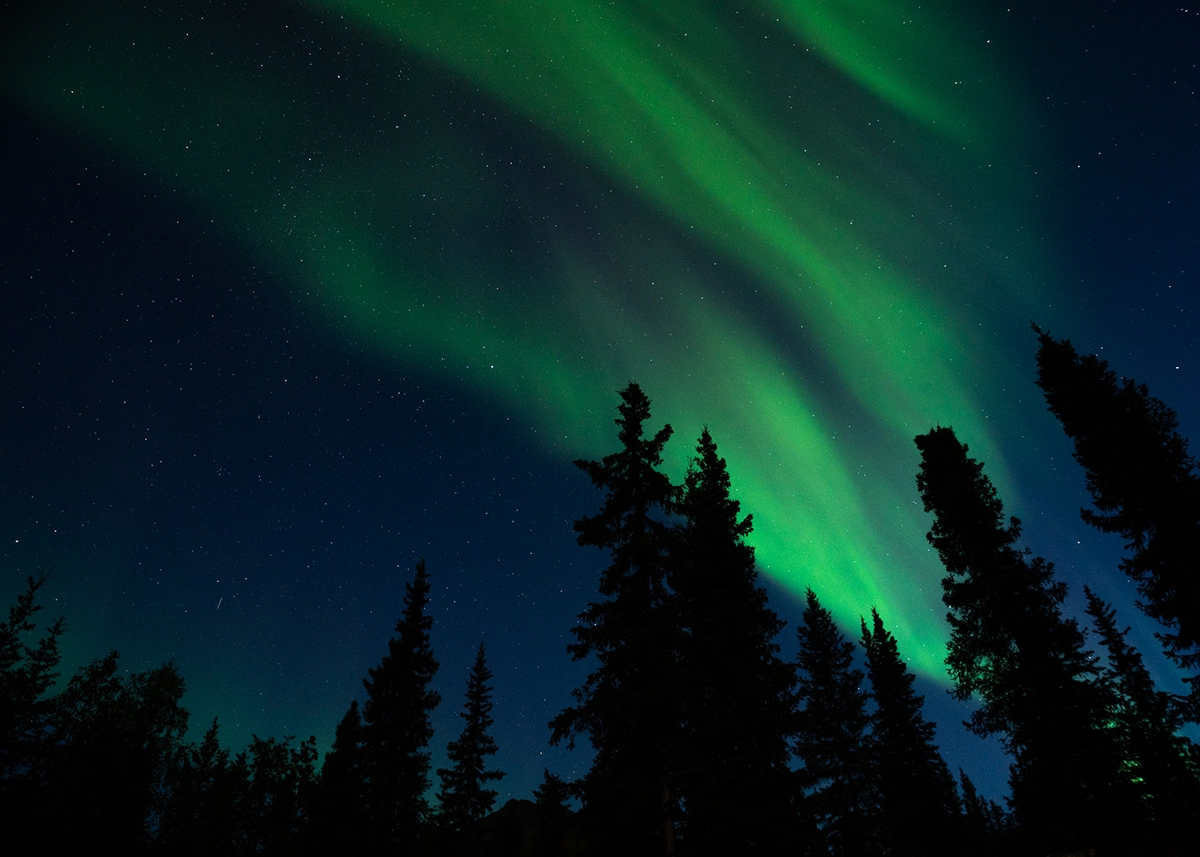
When night falls in Alaska’s Arctic, the world exhales. The wind softens, the tundra quiets, and the sky begins its show. Each aurora display feels like witnessing the Earth breathe light—a defining part of Northern Lights photography in Alaska.
Chasing the Glow
Patience is everything when capturing the aurora in Alaska. Some nights, they arrive in a whisper, a faint green arc low on the horizon. Other nights, they explode into motion, dancing in ribbons that twist across the stars and silhouette the spruce trees.
Gear and Setup
For this trip, I relied on the Tamron 17–50mm F/4, one of the best lenses for Alaska landscape photography when shooting the aurora. Its wide coverage and edge-to-edge clarity were perfect for the sweeping glow over the Brooks Range and tundra.
My Go-To Settings
Each show is different—sometimes fast and bright, other times faint and slow. Adjusting exposure is part of the chase that defines Northern Light photography.
- Shoot in manual mode.
- Use ISO 1600–3200 to start.
- Set shutter speed between 4-10 seconds at f/4
- Use manual focus on a bright star or distant light before the aurora begins.
- Once sharp, tape the focus ring to avoid accidental movement.
- Shoot in RAW to preserve every subtle hue the naked eye might miss.
Feeling the Silence
Standing beneath the lights, the mountains echo the glows with reflection from sky to stream. It’s silent, almost sacred. Out here, far from what most consider civilization, the aurora is a reminder of how alive the darkness can be —a experience for anyone exploring Alaska photography workshops.
Tips for Traveling Light Without Missing the Shot
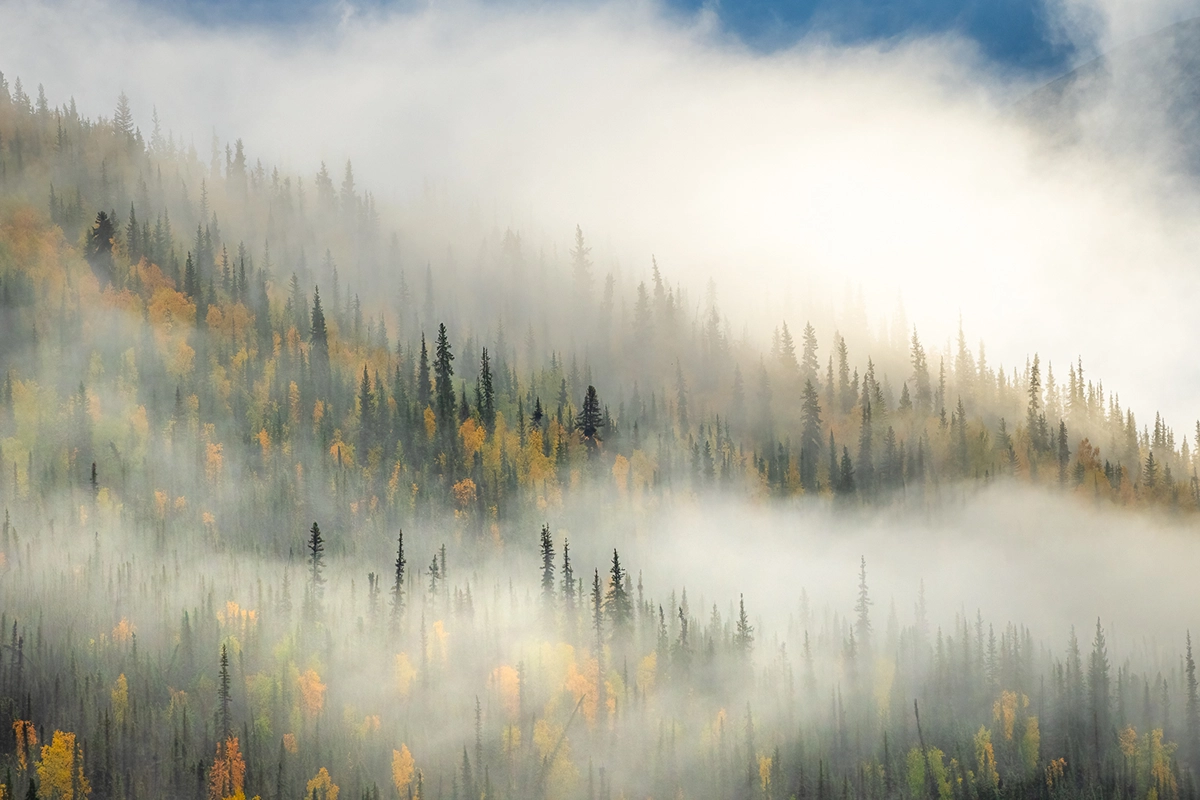
Alaska rewards the prepared and punishes the overloaded. On long drives and short hikes alike, I’ve learned that every extra ounce eventually feels heavier than it should. Traveling light keeps me moving and keeps creativity alive.
TIP 1: Streamline the Process
Carrying less means thinking more intentionally. Each lens, body, and battery earns its place. My two-lens, minimalist photography gear setup gave me all the range I needed without the weight or hesitation of constant gear swapping— ideal for both Alaska wildlife photography and Alaska landscape photography on the go.
TIP 2: Adapt in the Moment
Weather here changes by the hour: sun to sleet to snow. Keeping my minimalist kit within reach meant I could react quickly to a rainbow over the tundra or a caribou crossing the ridge. I also keep rain gear for myself close at hand; staying dry and comfortable keeps me ready for the next shot.
Pro Tip: Organize your gear so you can reach any item without setting your pack down. Quick access keeps you ready and protects equipment from mud, moisture, or unexpected gusts.
TIP 3: Switch to Crop Mode
When photographing with high-megapixel full-frame cameras like the Sony A1 or A7RV, I frequently find myself switching to crop mode for a 1.5× “zoom” without adding gear. Even at 21MP, files remain perfect for print or digital publication. It’s an efficient trick for maximizing a minimalist photography kit.
Creating Lasting Memories in Alaska’s Fall
Photographing Alaska in autumn is more than just images. It’s about connection with the land. The mix of color, weather, and solitude creates space to slow down and listen—to feel part of the rhythm rather than just an observer behind the lens.
Embracing Imperfection
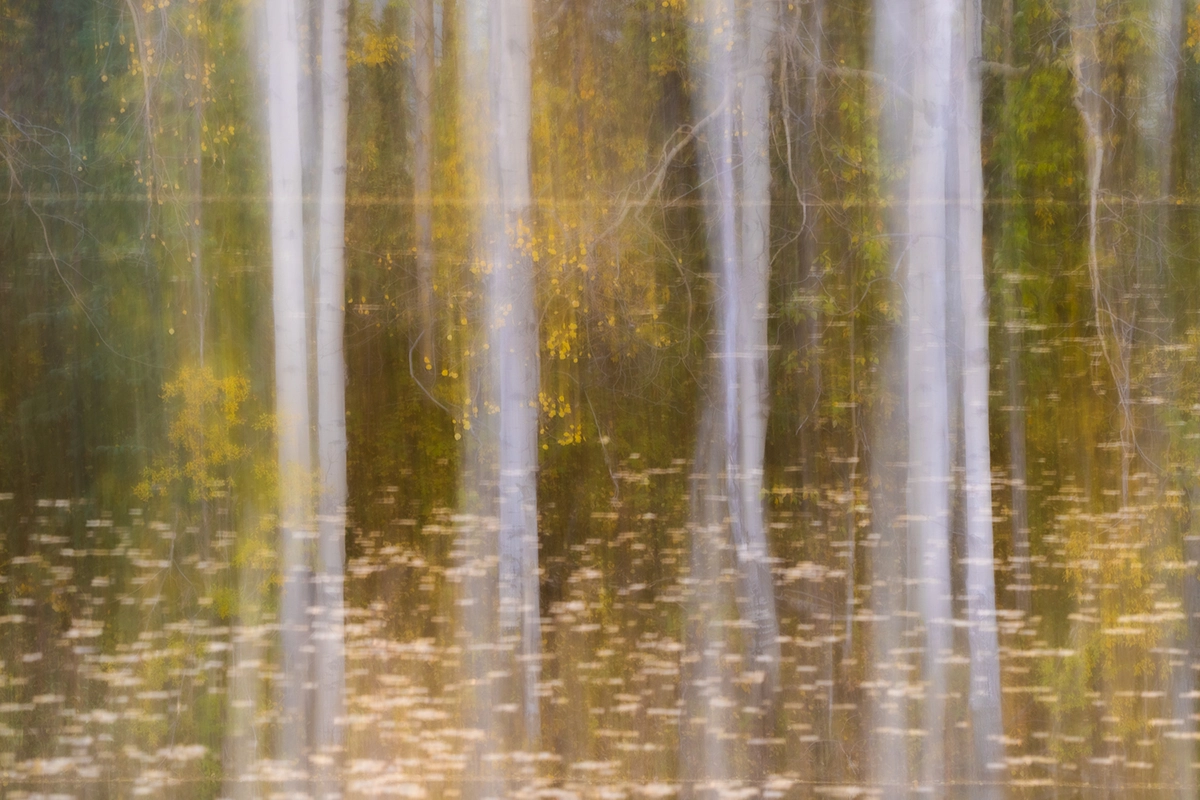
I’ve learned to appreciate the unpredictable—the shifting light, the fleeting wildlife, the sudden storms. These moments remind me that photography isn’t about control; it’s about presence, respect, and responding to what the land offers.
Pro Tip: Step outside the technical box and experiment with Intentional Camera Movement (ICM). A slow shutter and deliberate motion can turn familiar scenes into painterly expressions of light, energy, and emotion.
The Lasting Impression
What I remember most isn’t just the images; it’s the scent of tundra after rain, the silence beneath the Northern Lights, and the grounding connection to Alaska’s wild places. Each journey north renews my appreciation for Alaska’s landscapes and the privilege of photographing its ever-changing beauty.
Until next time, safe travels and interesting light! Cheers.
FAQs About Alaska Fall Colors Photography
1. When is the best time to photograph Alaska fall colors?
The best time to photograph Alaska fall colors is from late August through mid-September. In northern regions like the Brooks Range, color peaks early as tundra turns vibrant red and gold. For those following autumn southward, Interior Alaska and the Kenai Peninsula transition through late September, making it ideal for both landscape photography Alaska and wildlife photography Alaska.
2. Where can I find the most vibrant fall foliage in Alaska?
Top spots for fall foliage Alaska include Denali National Park, the Dalton Highway, and the Brooks Range. The tundra in these areas transforms into sweeping carpets of orange, crimson, and gold, offering some of the most breathtaking Alaska landscapes of the year.
3. What camera gear do I need for Alaska fall photography?
A minimalist setup works best for Alaska’s rugged terrain. A wide-to-mid zoom like the Tamron 17–50mm is perfect for landscape photography Alaska, while a telephoto such as the Tamron 50–400mm lets you capture wildlife at a safe distance. Both lenses are lightweight, weather-sealed, and ideal for variable conditions.
4. How do I capture the aurora in Alaska during fall?
For photographing the aurora in Alaska, use manual mode with ISO between 1600–3200, f/4 aperture, and a shutter speed between 4–10 seconds. Choose a clear, dark night away from city lights, and focus manually on a bright star before the show begins. A sturdy tripod and patience are essential.
5. Are there good wildlife photography opportunities in Alaska’s fall season?
Absolutely. Fall is peak season for wildlife photography Alaska, as bears feed before hibernation and caribou migrate across open tundra. Early mornings and late afternoons provide dramatic light and active animal behavior.
6. How do I prepare for Alaska’s unpredictable fall weather?
Layer clothing, pack waterproof gear, and protect your camera with rain covers. Conditions can shift from sunshine to snow quickly, especially along the Dalton Highway. Staying ready helps you adapt for both autumn photography tips and safety in the wild.
7. Can I see both fall colors and snow in the same trip?
Yes — in late August and early September, you can often photograph Alaska fall colors alongside the first snow in the Brooks Range. This overlap creates striking contrast and texture that make your landscape photography Alaska truly unique.
8. Do I need a guided tour, or can I explore on my own?
Both options work. Independent travelers enjoy flexibility, while guided Alaska photography tours provide expert insight into timing, locations, and wildlife safety. Alyce Bender’s workshops, for example, emphasize ethical photography, creativity, and connection with the land.
Ready to Photograph Alaska Fall Colors? Find Your Tamron Lens for Your Alaska Photography Tour
If this guide inspires your own Alaska fall colors adventure, choose gear that balances performance and portability. Tamron’s weather-sealed zooms are built for the challenges of Alaska photography—from fall foliage Alaska to the aurora in Alaska—ensuring that no moment escapes your lens.
Learn more about the lenses Alyce used in Alaska, and more Tamron lenses for at an authorized Tamron dealer near you or shop directly at the official TAMRON Store.
About Alyce Bender
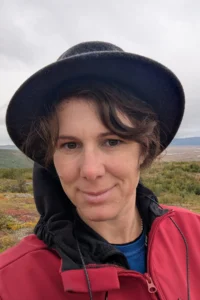
Alyce Bender is a professional nature photographer, writer, educator, U.S. Air Force veteran, and Tamron Americas ambassador. Her passion for the natural environment compels her to connect others with nature through education and experiences that promote conservation, creativity, and ethical photography. Her work has been featured in group and solo shows across the U.S. as well as in domestic and international publications from the U.K. to Japan. When leading tours, Bender’s goal is to help photographers expand their personal vision and naturalist skills. When not in the field, she offers a variety of educational and mentorship programs. Website | Instagram